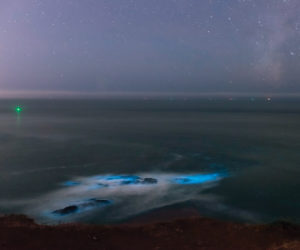Q: Every year I lead a July 4th hike up Bald Mountain in Kenwood. Every year, as we head down the hill in the dark, we see what I call “glow worms.” The specimen I once held in my hand was a quarter-inch brown worm with a glowing tail. What are these creatures? [Bill, Kenwood]
A: Bill, I too have encountered those glowworms, not often but regularly. I strongly suspect that they are western banded glowworms (Zarhipis integripennis).
Bioluminescence is simply the creation of light by living organisms. The basic chemical reaction involves a compound called luciferin, an enzyme called lucerifase, and the addition of that great fiery compound common on our planet, oxygen. This chemical reaction emits light without heat, a rare event in nature.
There are many different kinds of bioluminescent organisms. I have lived in the San Francisco Bay area for over 30 years and there are only three things I miss from my birthplace in the South: dramatic electrical storms, warm summer nights, and, last but not least, fireflies, which are probably the best-known bioluminescent critters. But the most common groups are found in the ocean: jellyfish and their relatives, bacteria, and dinoflagellates. Here on terra firma, we have glowing fungi, but by far the largest group is–surprise, surprise!– the beetles (which include fireflies and glowworms).
Obviously there has to be a strong reason for an organism to emit light. In the case of fireflies, the flashing lights usually are related to sexual reproduction: The lights help males and females find each other. This is certainly evident in the fantastic displays of flashing lights of the males and the softly glowing lights of the females sitting on the ground–a common sight in many warm, humid environments.
However, our western banded glowworm (which is a type of beetle) is a bit different from the ones found in the eastern United States. The female is larviform, meaning she never actually matures into the adult winged form like the male but remains all her life like the juvenile. The one you held, Bill, could either have been the larva or a female; they are nearly impossible to tell apart. Both specialize in eating millipedes. They bite the millipedes just below the head and paralyze them and then eat them from the neck down. Yummy!
The light emitted by this larva and the females is thought to be aposematic. This is a fancy word that literally means off (apo) sign (sema): Far from attracting mates, it’s a danger sign that this insect is toxic to predators. So in this case the bioluminescence has nothing to do with reproduction.
I hope I have shed some light on the subject.
Send your questions to atn@baynature.org.

